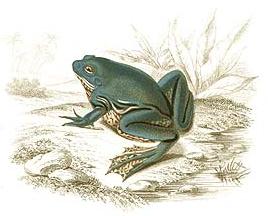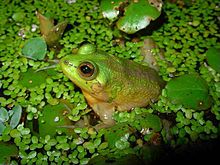Large harlequin frog
| Large harlequin frog | ||||||||||||
|---|---|---|---|---|---|---|---|---|---|---|---|---|

Great harlequin frog ( Pseudis paradoxa ) |
||||||||||||
| Systematics | ||||||||||||
|
||||||||||||
| Scientific name | ||||||||||||
| Pseudis paradoxa | ||||||||||||
| ( Linnaeus , 1758) |
The great harlequin frog ( Pseudis paradoxa ), also known as the paradoxical frog , is a frog from the tree frog family (Hylidae). It is an unusual representative of the harlequin frogs ( pseudis ), which as a tadpole can be up to 25 centimeters long, but as an adult animal shrinks to a length of only 4.5 to 7.5 centimeters.
Several substances with an antimicrobial effect that are of interest for medical applications could be isolated from the skin secretion of Pseudis paradoxa .
description
The great harlequin frog is similar in appearance to the pond frog . It is green with dark green to olive green stripes. In the female animals, the throat region is whitish light with scattered speckles. The head is short and pointed at the front, the eyes are bulging. The oval pupils are positioned horizontally. The skin is very slippery. With webbed equipped between the toes hind legs are strong and much longer than the front legs. The splayed thumb is noticeable on the front legs, the long fingers are used to catch prey and dig in the mud. To strengthen the legs, Pseudis paradoxa has an additional bone between the two outer toes.
Because of this physique, the great harlequin frog is very well adapted to life in the water. It spends its life almost exclusively in the water, mostly swimming just below the water surface and hidden by plants, but can easily survive dry periods by digging into the ground. The great harlequin frog feeds mainly on insects and smaller amphibians.
The great harlequin frog is one of the nocturnal frogs; the animals are only active during the mating season during the day. During the mating season, the males, who are usually slightly smaller than the females, lure them in with their characteristic croaking. The females lay the foamy spawn on aquatic plants, and the eggs are fertilized outside the body.
The embryos grow into greenish tadpoles with an extremely unusual length. While the adults are only 4.5 to 7.5 cm long, the larvae reach a length of up to 27 cm after four months shortly before their metamorphosis , which is three to five times as large as after the metamorphosis. Although the great harlequin frog is one of the smaller frogs, its larvae are the largest known tadpoles. It is believed that the growth of the larvae is triggered by the hormone prolactin .
Because of its unusual development, the frog was named "Paradoxical Frog". The first reports about these frogs wrote, irritated, of a reverse development of frogs to tadpoles. During her expedition to Suriname around 1700, the natural scientist Maria Sibylla Merian first described Pseudis paradoxa as a frog that "turns into a fish." The first scientific description was in 1758 by Carl von Linné .
Five subspecies are known of the great harlequin frog:
- Pseudis paradoxa paradoxa
- Pseudis paradoxa caribensis
- Pseudis paradoxa platensis
- Pseudis paradoxa occidentalis
- Pseudis paradoxa nicefori
distribution
The great harlequin frog is widespread on the island of Trinidad and on the South American continent east of the Andes from Colombia to northern Argentina . The frog prefers stagnant water and is found in tropical and subtropical climates at heights of up to 1000 m.
The tadpoles are considered a delicacy in some regions of South America; since the great harlequin frog is very shy, its population is not considered endangered. Pseudis paradoxa is rarely kept in terrariums , and little is known about the breeding of these frogs.
particularities
Four peptides were isolated from the skin secretion of the great harlequin frog , the antimicrobial effect of which has been proven in laboratory tests. These pseudines protect the frog from infection.
With the peptide Pseudin-2 synthesized in the laboratory, scientists from the University of Ulster in Northern Ireland and the University of the United Arab Emirates in Al-Ain demonstrated in early 2008 that this substance can stimulate the formation of insulin in the human body. This means that Pseudin-2 could be used to treat type 2 diabetes mellitus . Regarding the mechanism of action is one Pseudin-2 to the new class of incretin mimetics , whose most representative tester, the active ingredient exenatide , is also of animal origin.
Individual evidence
- ↑ Sharon B. Emerson: The giant tadpole of Pseudis paradoxa . In: Biological Journal of the Linnean Society. 1988, 34 (2), pp. 93-104, ISSN 0024-4066 , doi : 10.1111 / j.1095-8312.1988.tb01951.x .
- ↑ quoted from, Encyclopædia Britannica . 11th edition. Volume 26, p. 354.
- ↑ MT Rodrigues, A. Acosta-Galvis, A. Mijares, E. Lavilla, R. Lajmanovich, J. Faivovich, J. Hardy: Pseudis paradoxa . In: 2007 IUCN Red List of Threatened Species ; accessed on March 18, 2008.
- ↑ L. Olson, AM Soto, FC Knoop, JM Conlon: Pseudin-2: an antimicrobial peptide with low hemolytic activity from the skin of the paradoxical frog. In: Biochemical and biophysical research communications. Volume 288, Number 4, November 2001, ISSN 0006-291X , pp. 1001-1005, doi : 10.1006 / bbrc.2001.5884 , PMID 11689009 .
- ^ Yasser HA Abdel-Wahab, Gavin J. Power, Ming T. Ng, Peter R. Flatt, J. Michael Conlon: Insulin-releasing properties of the frog skin peptide pseudin-2 and its [Lys18] -substituted analogue . In: Biological Chemistry . 2008, 389, pp. 143-148, ISSN 1431-6730 , doi : 10.1515 / BC.2008.018 .
- ↑ Paradoxical frog's leap forward for diabetes ( Memento of the original from November 19, 2008 in the Internet Archive ) Info: The archive link was automatically inserted and not yet checked. Please check the original and archive link according to the instructions and then remove this notice. . Diabetes UK press release March 3, 2008; accessed on March 19, 2008.
literature
- Dave Showler: Frogs and Toads . St. Martin's Press, New York 2004, ISBN 0-312-32241-0 , p. 151.
- David Rose: Jungle frog's anti-infection agent may help millions of diabetics . In: The Times . March 3, 2008.
Web links
- AmphibiaWeb (English)
- Tree of Life web project David Cannatella: Pseudidae. (English)
- Pseudis paradoxa inthe IUCN 2013 Red List of Threatened Species . Posted by: Ariadne Angulo, Diego Baldo, 2008. Retrieved October 24, 2013.
